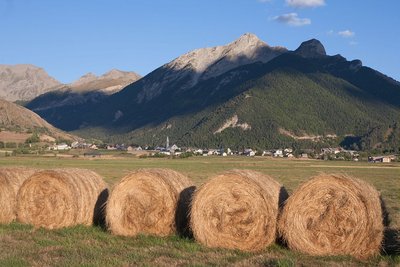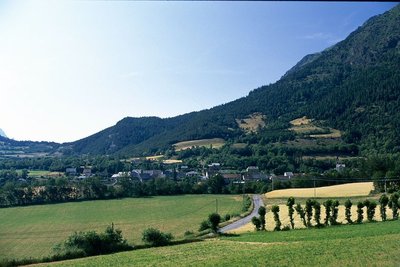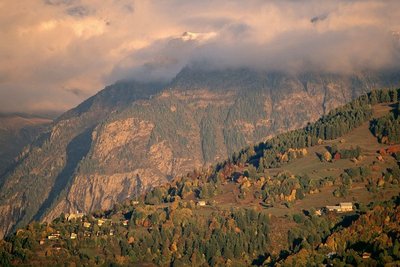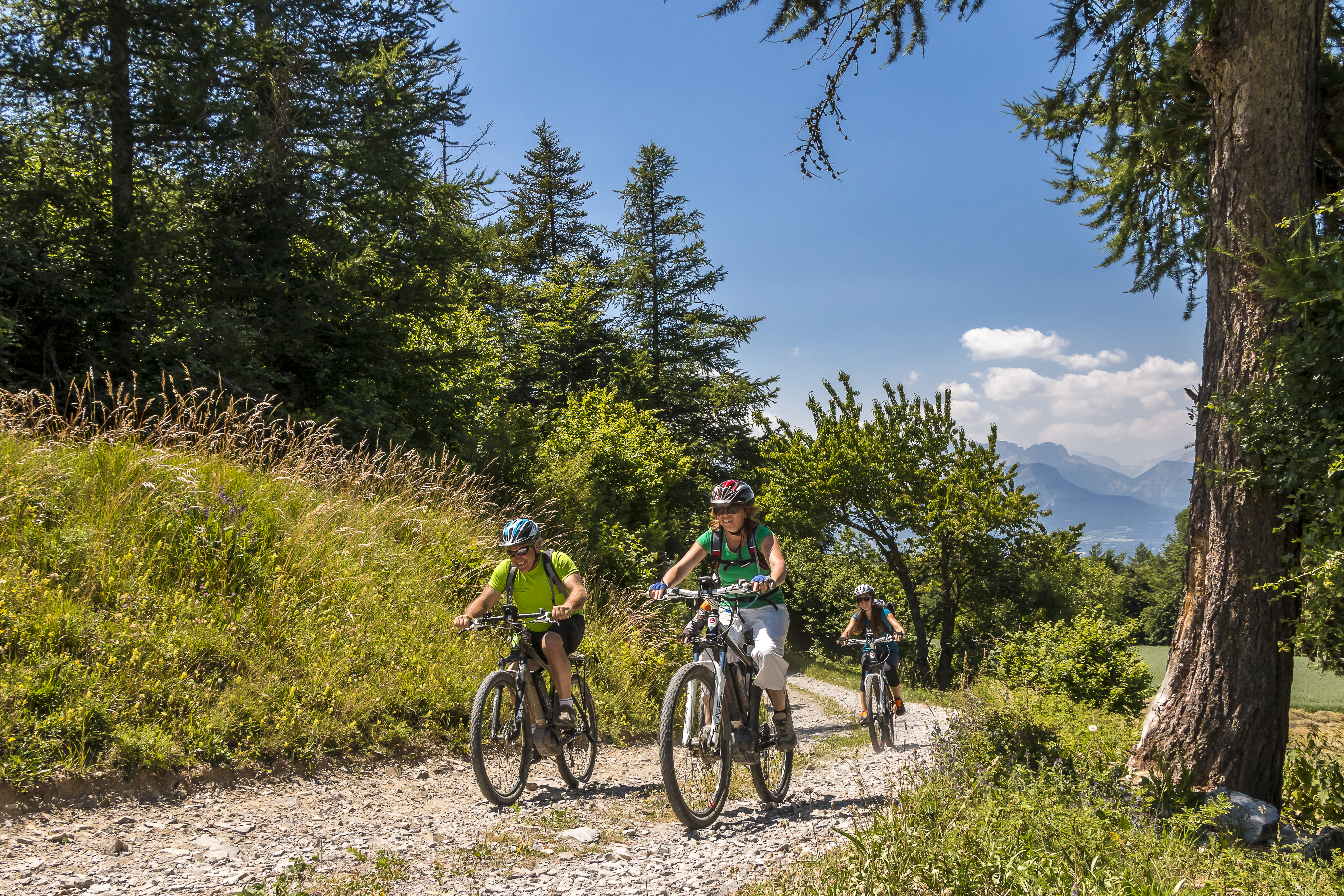
Tour of Champsaur by mountain bike - 3 days
Setting off on a discovery of Champsaur to encounter varied and sunlit landscapes is all part of the experience of this trail. At each Stage, the backdrop changes radically, alternating between a high mountain environment and Mediterranean influences. Splendid landscapes open up over the valley and the Parc National des Écrins. No-one will be disappointed by this Tour.
3 steps
Description
The entire circuit, in particular its initial section, is quite fast with no really difficult or technical stretches. The routes along the valley bottoms run gently along farm tracks and quiet little roads. Fortunately, the ascents through forested areas - some of them long - are shaded and lead up to the alpine pastures of each slope. The balcony paths you then use (especially on the very beautiful second stage), run along or drop down via technical and fun singles treks. The day is spent well, with mind and body tested! The beautiful panoramic stopping points encountered all along the physical stretches will be welcomed as an opportunity to eat, contemplate... or have a siesta!
- Departure : Ancelle
- Arrival : Ancelle
- Towns crossed : Ancelle, La Bâtie-Neuve, Forest-Saint-Julien, La Rochette, Gap, Laye, La Fare-en-Champsaur, Poligny, Le Noyer, Chauffayer, Saint-Eusèbe-en-Champsaur, Les Costes, La Motte-en-Champsaur, Les Infournas, Bénévent-et-Charbillac, Saint-Bonnet-en-Champsaur, Saint-Julien-en-Champsaur, Saint-Michel-de-Chaillol, Saint-Jean-Saint-Nicolas, Champoléon, Orcières, Saint-Léger-les-Mélèzes, and Chabottes
36 points of interest

Gap depuis faudon - Marc Corail - PNE  Panorama
PanoramaView over Gap
To the south of Champsaur, the town of Gap is the administrative centre of Hautes-Alpes, with a little over 40,000 inhabitants. It stands at an altitude of 700 m on a major communications route between Provence and the Alps, and enjoys generous rates of sunshine with large natural areas in the vicinity. In 2013, L'Equipe newspaper voted the town of Gap as France's most sports-oriented town of over 20,000 inhabitants.

 History
HistoryCanal de Gap
Work began on the canal in 1864 and was completed in 1880. The canal is 28 km long, and takes its water from the River Drac, upstream of Pont du Fossé, before channelling it into the Gap basin. In today's money, it cost some 2 billion euros to build! The man in charge of the project, Maurice Garnier, a local member of parliament and contractor, went bankrupt and died in poverty, but managed to improve the life of local farmers.
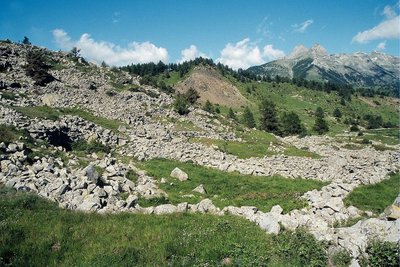
Faudon - les murets et les clapiers d'épierrement - Marc Corail - PNE  Archaeologie
ArchaeologieArchaeological site of Faudon
A quick ride takes you past the Croix Saint-Philippe to the remains of the Gallo-Roman village of Faudon, meaning mountain of fayards or beech trees) Settled during the Bronze Age by the Tricorians with a population of up to 400, in the Middle Ages this village became a stronghold for the local nobles before being abandoned in the seventeenth century.

 History
HistoryOld Champsaur railway line
1912 saw the start of the Champsaur rail works, an old project for a line between Grenoble and Gap which was intended to pass through Champsaur. In service from 1932 onwards, the Mure to Corps section was an undoubted success. From Corps to Gap, the earthworks and engineering works were almost totally complete. However, the onset of the War, a lack of resources and the development of cars all brought the project to an end in 1941. Today, numerous structures along the route bear witness to this past endeavour.

 Fauna
FaunaMouflon
If you make a detour to the Col de Gleize, you may well see some mouflons. An ancestor of the sheep with ammonite horns, it was introduced from 1949 into the Alps from herds in Corsica and central Europe, and seems well settled in the Chaudun area. Even though the European Union recommends strict protection of the mouflon, it is still hunted during the hunting season. Its populations are ill-adapted to extreme Alpine conditions and can fluctuate according to the winter weather.

 Know-how
Know-howONF
The work of the Office National des Forêts (National Forestry Office) is not limited to the forests. After buying a large amount of land following the rural exodus (public land), the state delegated to the Water and Forestry agency the difficult task of preserving the natural heritage of a large number of areas (restoration of land and building, maintenance of paths, etc.)
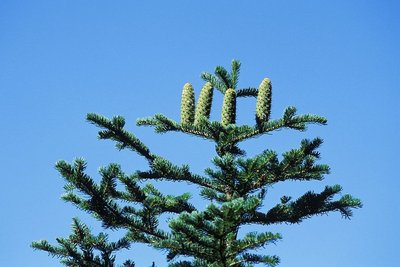
Cônes de sapin blanc - Parc national des Ecrins  Flora
FloraFir
100 metres below the Cabane des Pierres stands the oldest and biggest fir tree in Champsaur. It is a European silver fir (Abies alba). The silver fir is often confused with the spruce (Picea abies). A tip to tell them apart: the spruce has cones that hang under the branch with needles all around the branch, while the fir has upright cones and rows of needles that stand out through having two small white lines underneath them.
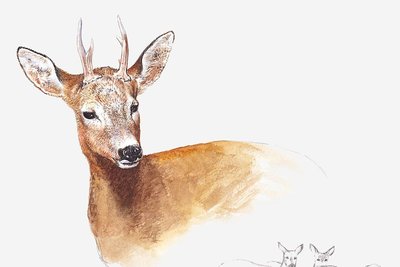
Chevreuil - Pierre-Emmanuel Dequest -PNE  Fauna
FaunaRoe deer
Walnut forests are a favourable home for roe deer. They came from Italy, the Isère and Drôme regions, and were added to some forty animals that were released between 1969 and 1975 in the neighbouring forests of Durbon and Morgon. This timid animal can be recognised by its red-brown coat and white patch on its rear.

 History
HistoryDominique Villars
The botanist Dominique Villars was born in Noyer in 1745. From an early age he was interested in botany, and with his friend, Dominique Chaix, a priest and botanist from Roche des Arnauds, he discovered many new species. He wrote "L'histoire des plantes du Dauphiné" (History of Plants in the Dauphiné), bringing together 3,000 species. Shortly before his death in 1814, Napoleon Bonaparte appointed him botany professor at the Strasbourg Special Medical School.
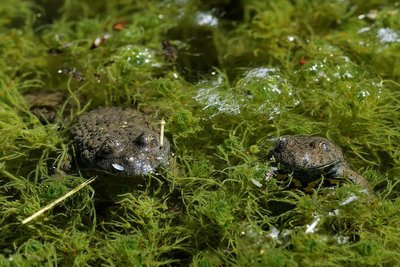
Sonneur à vendre jaune - Mireille Coulon - PNE  Fauna
FaunaYellow-bellied toad
Between the mountains and the River Drac, the water flows down as mountain streams and irrigation canals, hollowing out the sediment in the fluvial-glacier terraces where the mountain pastures have emerged. As the layers of eroded material of varying size and with impermeable clay layers are built up, sources are formed and feed small ponds. The yellow-bellied toad is a small toad that flourishes in habitats like these. The species is in decline all over its area of distribution due to the reduction in the number of such habitats. This is caused by draining, the creation of dams, levelling work and timber transport, among others. The population of this small amphibian is monitored by the National Park authorities.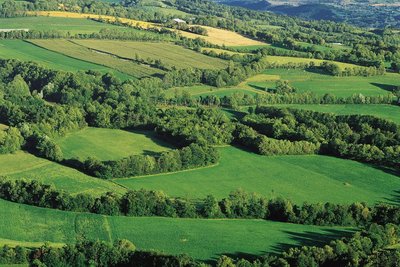
Bocage du Champsaur-Valgaudemar - Stéphane D'houwt - PNE  Flora
FloraThe Chamsaur woodlands
The woodland landscapes in lower Champsaur are unique in the Hautes-Alpes region. The network of hedges and canals surrounding the parcels of land result in agriculture of a high quality. Thanks to funding from the region and the EU in favour of maintaining the cultural and biological heritage, 70 species of trees and bushes, and over 80 bird species can be found here.

Le lac du Lauzon dans la vallée du Valgaudemar - Dominique Vincent - PNE  History
HistoryValgaudemar
Tradition says the name of the valley comes from the Burgundian chief Gaudemar, who took refuge here in the 6th century. The local inhabitants lived for a long time from subsistence farming and mining. Mountain-climbing began to take off in the second half of the 19th century, and tourism in the 1960s. There are 30 peaks over 3,000 m. The highest point, Les Bancs (3,669 m), stands at the end of this long, narrow glacier valley.

Aigrette garzette - Damien Combrisson - PNE  Fauna
FaunaOrnithologial diversity
Thirty years of careful inventories have identified 220 species of bird in the valley. This exceptional variety is not only due to the landscapes (hedges, wetlands, forests and high mountains) but also to the Champsaur's geographical position: not quite north-alpine, wide open to the south with the Manse and Bayard thresholds, ideal for exchange and for migratory birds such as herons, ducks, red-footed falcons or flycatchers.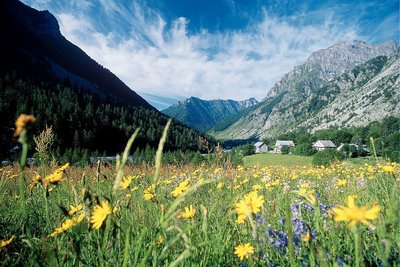
Prairie de fauche dans la vallée de Champoléon - PNE  Flora
FloraHayfields
When they have not been disturbed by modern fertilisation techniques and silage, around fifty species of plant can still be found in the hayfields. The most symbolic are the poet's daffodil, alpine salsify, meadow sage, sainfoin and globeflower that punctuate the landscape with their different colours.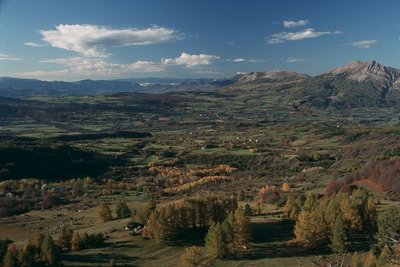
Le bocage du Champsaur, Saint-Michel-de-Chaillol - PNE  Flora
FloraHedging
Hedged landscapes were quite common in France before the war, but here, above an altitude of 1000 m, a wonderful diversity has been maintained. A patchwork of hedgerows, prairies and woods are home to an array of birds. Amongst them are many common sparrows (red-backed shrikes, stonechats, sparrows, quails and wrynecks) whose numbers are in decline in France, sometimes alarmingly so. Richness is therefore not solely due to rarity.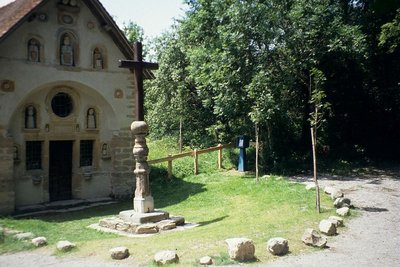
La chapelle des Pétêtes - Hervé Cortot - PNE  History
HistoryPetetes Chapel
This chapel is an oddity as well as a remarkable piece of popular art. Here the "pepetes" are dolls! The story says that in 1730, a shepherd named Pascal, who also happened to be a mason, started chipping rocks. All winter he chipped away at the rocks. When he had chiselled enough, he dug the ground and placed the stones on top of each other. When he finished, the hamlet of Aubérie had a pretty, little mountain chapel. The mysterious shepherd had created small alcoves in the chapel's facade. He started chiselling again, but this time with greater precision and love, as he was sculpting statues. In 1741, after working 11 years, he finished his work of art and placed a monumental cross in front of the chapel.
Les Infournas Hauts - Parc national des Écrins - Marc Corail  Geology and geography
Geology and geographyLes Infournas
The locality is made up of two hamlets:
- Les Infournas-Bas, former administrative seat of the municipality, with the mayor's office and the church, standing at 1,245 metres above sea level.
- Les Infournas-Hauts, a starting point for mountain hiking, which stands at 1,373 metres above sea level.
It is only possible to access the Drac valley, a lifeline for the region, via two winding roads, one to the north-west towards Chauffayer 10 km away, the other to the south towards Saint-Bonnet-en-Champsaur which is 7 km away. Most of the territory is made up of the inhospitable and extensively ravined slopes of the mountains Le Cuchon and Le Queyron. To the south, woods constitute its only real resource.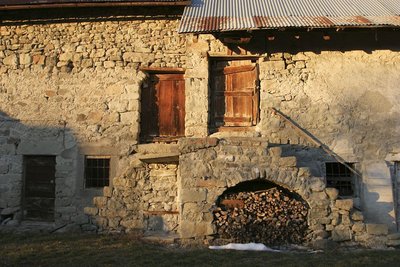
Une ferme aux Roranches, Champsaur - Marc Corail - PNE  Architecture
ArchitectureChampsaur architecture
Today's landscapes and the houses are no accident. They bear the trace of humans, who were less concerned with building attractive places, than with striving to find the best rigorously functional solutions for the area. In the northern part of the Drac valley, an area often faced with a cold wind, hedges were planted, buildings were close together and almost blind on the north-facing side. On the balconies to the east, as in St-Michel-de-Chaillol or St-Julien-en-Chapsaur, the aim was to find sunlight and the facade often had a large porch.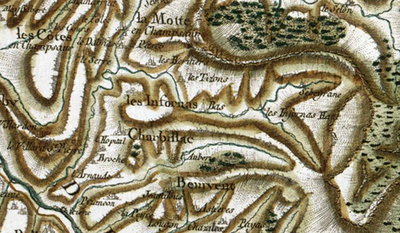
Carte de Cassini - IGN  History
HistoryThe origin of the name "Champsaur"
A dozen origins explain the name "Champsaur". Obviously the prettiest one, and the least likely, is that it means "champ d'or" (Field of gold) as Napolean is said to have shouted out "what a beautiful field of gold" upon discovering the area. Other explanations are "field of lizards (sauros meaning lizard in greek) or "Sarrasins field" (campus sauracenorum) due to their numerous invasions. However, the most likely explanation is that it comes from "campus saurus" the field or the land of Saurus, the name of the owner at the time.
Le Vieux Chaillol, nuages et lumière du soir depuis Ancelle - Mireille Coulon - PNE  Geology and geography
Geology and geographyLe Vieux Chaillol
Easily visible from Champsaur and from beyond Gap, Le Vieux Chaillol is, like the Ecrins range, made up of granite rocks originating in the bedrock of the Cambrian era and which suddenly rose up some 5 million years ago. But the rocks of Le Vieux Chaillol have undergone a particular recrystallisation and have been transformed into metamorphic conglomerates and schists.
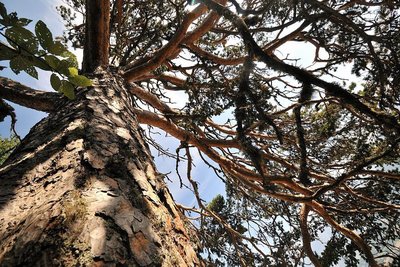
Vieux Pin sylvestre - Mireille Coulon - PNE  Flora
FloraScots pine
The Scots pine can be recognised by its long reddish brown trunk and sparse foliage. The needles are grey-green, slightly curved and paired. It needs a great deal of sunshine, but can make do with poor, sandy soil that is unsuited to other trees. Its wood is light and of high quality.

La Chapelle des Roranches - © Parc national des Écrins - Michel Francou  Vernacular heritage
Vernacular heritageLes Roranches Chapel
Built in 1780 on the site of a former chapel dedicated to Our Lady of the Assumption, the Roranches chapel is dedicated to Saint Pancras, the protector of farm animals and pets. It was built using humble architectural techniques, and is highly representative of the small places of worship in the Champsaur woodlands where, as so often in the mountains, the materials used were those that were ready to hand. Two renovation projects have been carried out on the chapel since 2013 with the support of the Ecrins National Park. The first was aimed at stabilising the barrel vault and renewing the framework and roof using the original material, slate. The second project was to restore the plasterwork inside and outside, as well as the whitewash, windows and flooring.
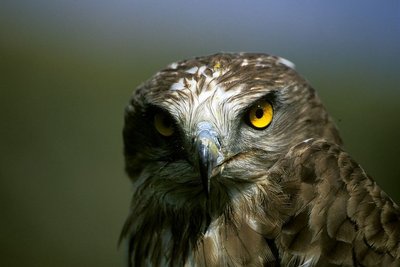
Circaète Jean-le-Blanc - Marc Corail - PNE  Fauna
FaunaShort-toed snake eagle
This bird of prey can be recognised because of its large head, its quite impressive wingspan (1.80m) and the white plumage under its wings and body. Despite its size, it rarely eat small mammals. Its food mainly consists of lizards and snakes. When it hunts, it takes up a particular position against the wind, poised in the air with its wings fully outstretched.

 Vernacular heritage
Vernacular heritageLes Richards
Perched up at an altitude of 1548 m above Pont-du-Fossé in the commune of Saint-Jean-Saint-Nicolas, the village of Les Richards is a haven of tranquillity. The view is breathtaking over the Autanes and the Champsaur woodlands. This is the starting point for a very popular hiking trail around the mountains or to the summit of the Palastre, and a take-off area for long-distance hang-gliders. It is not unusual for a hang-glider to land in Grenoble and sometimes even in Chamonix after a long day's flight from Les Richards! The record is 162 km, with a landing in Chamonix in 2002.
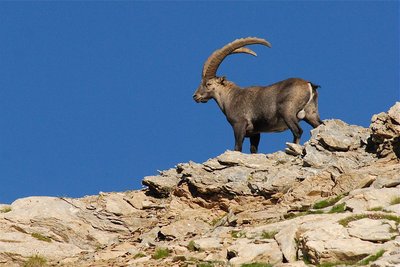
Bouquetin en été - Rodolphe Papet - PNE  Fauna
FaunaAlpine ibex
If you take a few minutes' walk at the end of the valley, you will be able to see some Alpine ibex. In September 1994, in Champoléon, some thirty animals from Vanoise area were released by Ecrins National Park rangers. This superb animal is heavier (100 kg) and less timid than the chamois, and is closely related to the domestic goat. It was almost extinct in the Alps. Today it is totally protected in France and is now safe extinction.
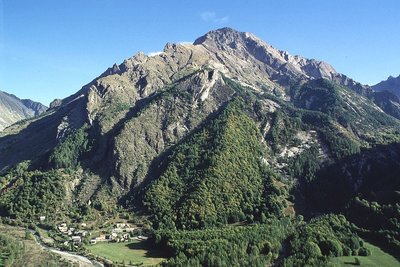
Le village des Borels - Marc Corail - PNE  History
HistoryLes Borels
This is most important village in the Chamoléon district (no hamlet bears this name). Until towards the first world war in 1914, the valley lived in a closed circuit for all everyday items. At the Borels there was a weaver (wool and hemp), a miller-baker, an ironmonger, a mason, a breeches-maker and in the other hamlets, a cobbler, two millers, a joiner and two shoemakers. The latter worked from home.
La Maison du Berger - Les Borels - Marc Corail - PNE  Vernacular heritage
Vernacular heritageThe Shepherd's House
Opened in memory of the shepherd and writer Pierre Mélet, the Maison du Berger ("the Shepherd's House") is a discovery and research centre focusing on Alpine pastoral cultures. It is a site of cultural outreach for all members of the public. There is an exhibition, educational activities for school groups, as well as a library for professionals and researchers, and a shop.

Pré fauché - Stéphane D'houwt - PNE  Pastoralism
PastoralismMown meadows
Most of the prairies are mown. They are lightly manured by the animals grazing here in spring and with additional manure. This land is rich in plant species: globeflowers, geraniums, narcissus, etc. The meadows that are only grazed are covered with large plants that are of no interest to cattle: asphodels, yellow gentians, veratrum, etc.
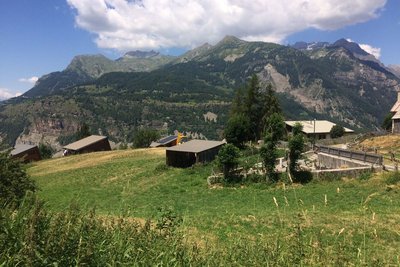
Serre-Eyraud - Parc national des Ecrins - CDTE05  History
HistorySerre-Eyraud
Serre-Eyraud is both a mountain village and a winter sports resort which overlooks
the Champsaur and the confluence of the Drac Noir and the Drac Blanc, 1,450 metres above sea level, opposite the Champoléon valley.
The resort was created in 1962 by a handful of inhabitants: eight runs lead through a larch forest which is exposed to the north, which helps to conserve the snow cover. Serre- Eyraud is the smallest ski resort in the Champsaur valley.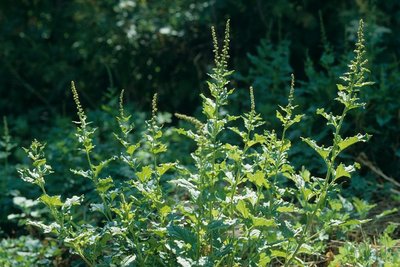
Chenopode du Bon roi Henry - Marcel Chaud - PNE  Know-how
Know-howPastoral plants
Around the shepherds' cabins can be found plants with pale colours that are useful in the kitchen : nettles, which cause rashes, but are used to make delicious soups, wild spinach, also known as Good King Henry , a plant eaten as a gratin (the famous 'oreilles d'âne' (donkeys' ears) dish), with the sour leaves of the Alpine dock. For dessert, the petioles of Monks' rhubarb leaves are served as jams and compotes.

Truite fario - Parc national des Ecrins  Fauna
FaunaTrout
Fishing fans have always loved the Drac. You also need some hiking skills to follow the course of the river or reach the high-altitude lakes. Whether you prefer lure fishing, spoon casting or fly fishing, here you'll find all kinds of trout: brown trout (Salmo trutta), Mediterranean in origin, and rainbow trout (Oncorhynchus mykiss) from North America.

Station Orcière-Merlette - François Labande - PNE  History
HistoryOrcières 1850
Thanks to Camille Ricou, the mayor of Orcières, and a handful of visionaries, in January 1962 the Orcières-Merlette ski resort was born. Soon, buildings, shops and ski lifts were built. Even though the 1960s architecture has not aged well and the pylons disfigure the landscape, the pioneers have achieved their aims: they were able to stay in the region, guarantee their children a future and create jobs.
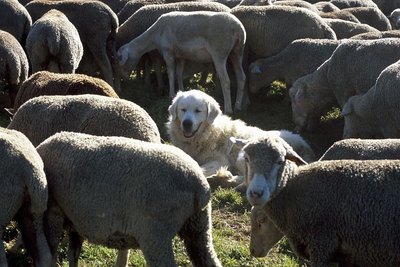
Patou surveillant le troupeau - Jean-Pierre Nicollet - PNE  Fauna
FaunaPatou
The patou is once again being used in the Alpine pastures by breeders and shepherds, following the reintroduction of wolves. Its role is to protect the sheep, not to herd them together like a sheep dog. The dog lives with the sheep from a very young age and considers them as members of its family. It barks and stands between the flock and whatever it sees as a threat. Since it is very protective towards the flock, hikers should make sure they keep their distance.
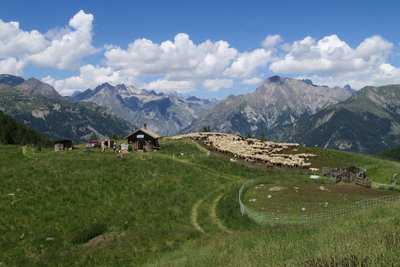
Alpage de Combeau - Parc national des Écrins - Marc Corail  Panorama
PanoramaThe Combeau alpine pasture
The Combeau alpine pasture, lying 2,000 metres above sea level.
Don't miss the superb panoramic view from the Croix de Combeau belvedere.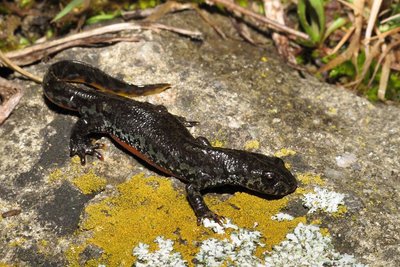
Triton Alpestre - Marc Corail - PNE  Fauna
FaunaAlpine newt
In the Libouze water reserve, newly restored by the town of Saint Léger les Mélèzes, you can see a pretty batrachian swimming around elegantly. This is the Alpine newt. It can be recognised by its orange belly, but unlike the females, the males have lighter-coloured sides with large dark spots and a narrow, light-blue stripe. The species is strictly protected and is becoming rarer in the plain, on the edge of its area of distribution.
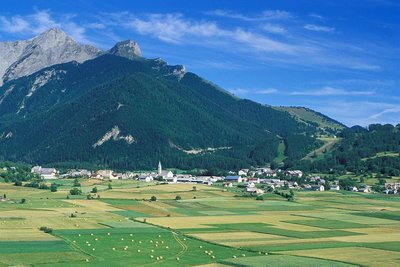
La plaine d'Ancelle - Marc Corail - PNE  Geology and geography
Geology and geographyThe Ancelle plateau
After the retreat of the glaciers flowing from the Durance and Roanne valleys, the frontal and lateral moraines formed a natural dam at the end of the Ancelle basin. Over time, a large glacial lake was created. Between the fifth and sixth centuries, the lake dried out. The forest then took over the fertile plateau, and it was only in the eighth century that it was deforested by man for crops.
Forecast
Altimetric profile
Sensitive areas
Golden eagle
- Impacted practices:
- Aerial, , Vertical
- Sensitivity periods:
- JanFebMarAprMayJunJulAug
- Contact:
- Parc National des Écrins
Julien Charron
julien.charron@ecrins-parcnational.fr
Short-toed snake eagle
- Impacted practices:
- Aerial,
- Sensitivity periods:
- MarAprMayJunJulAugSep
- Contact:
- Parc National des Écrins
Julien Charron
julien.charron@ecrins-parcnational.fr
Golden eagle
- Impacted practices:
- Aerial, , Vertical
- Sensitivity periods:
- JanFebMarAprMayJunJulAug
- Contact:
- Parc National des Écrins
Julien Charron
julien.charron@ecrins-parcnational.fr
Golden eagle
- Impacted practices:
- Aerial, , Vertical
- Sensitivity periods:
- JanFebMarAprMayJunJulAug
- Contact:
- Parc National des Écrins
Julien Charron
julien.charron@ecrins-parcnational.fr
Peregrine falcon
- Impacted practices:
- Aerial, Vertical
- Sensitivity periods:
- FebMarAprMayJun
- Contact:
- Parc National des Écrins
Julien Charron
julien.charron@ecrins-parcnational.fr
Peregrine falcon
- Impacted practices:
- Aerial, Vertical
- Sensitivity periods:
- FebMarAprMayJun
- Contact:
- Parc National des Écrins
Julien Charron
julien.charron@ecrins-parcnational.fr
Peregrine falcon
- Impacted practices:
- Aerial, Vertical
- Sensitivity periods:
- FebMarAprMayJun
- Contact:
- Parc National des Écrins
Julien Charron
julien.charron@ecrins-parcnational.fr
Short-toed snake eagle
- Impacted practices:
- Aerial,
- Sensitivity periods:
- MarAprMayJunJulAugSep
- Contact:
- Parc National des Écrins
Julien Charron
julien.charron@ecrins-parcnational.fr
Short-toed snake eagle
- Impacted practices:
- Aerial,
- Sensitivity periods:
- MarAprMayJunJulAugSep
- Contact:
- Parc National des Écrins
Julien Charron
julien.charron@ecrins-parcnational.fr
Black grouse - winter
- Impacted practices:
- , Land
- Sensitivity periods:
- JanFebMarAprDec
- Contact:
- Fédération départementale des chasseurs des Hautes-Alpes :
Pierre-Frédéric Galvin : pierre-frederic.galvin@fdc05.com
Membre de l'Observatoire des Galliformes de montagne
Virginie Dos Santos : ogm.vds@gmail.com
Blandine Amblard : ogm.amblard@gmail.com
Black grouse - winter
- Impacted practices:
- , Land
- Sensitivity periods:
- JanFebMarAprDec
- Contact:
- Fédération départementale des chasseurs des Hautes-Alpes :
Pierre-Frédéric Galvin : pierre-frederic.galvin@fdc05.com
Membre de l'Observatoire des Galliformes de montagne
Virginie Dos Santos : ogm.vds@gmail.com
Blandine Amblard : ogm.amblard@gmail.com
Recommandations
A trail that is more agreeable in autumn (ambiance and colours) rather than spring as the technical stretches are more cyclable, "cleaned" by the passage of hikers in the summer season.
Be sure to train thoroughly before embarking on three days of alpine mountain biking!
 In mountain pastures, protection dogs are there to protect the herds from predators (wolves, etc.).
In mountain pastures, protection dogs are there to protect the herds from predators (wolves, etc.).
When I hike I adapt my behavior by going around the herd and pausing for the dog to identify me.
Find out more about the actions to adopt with the article "Protection dogs: a context and actions to adopt".
Tell us about your meeting by answering this survey.
Information desks
Tourisme Office of Champsaur & Valgaudemar
Les Barraques, 05500 La Fare en Champsaur
Transport
SNCF train stations at Gap or Grenoble : https://www.sncf-connect.com/
Then regional bus lines : https://zou.maregionsud.fr/ ou https://carsisere.auvergnerhonealpes.fr/
Access and parking
From Gap, first take the N85 and then the D944 and finally the D13.
From Grenoble, after St-Bonnet take the D114 and the D514.
Parking :
Source

Report a problem or an error
If you have found an error on this page or if you have noticed any problems during your hike, please report them to us here:

